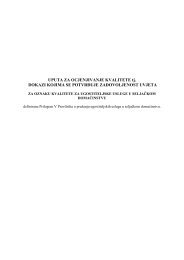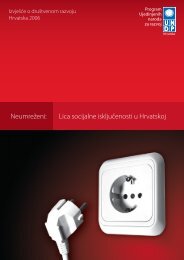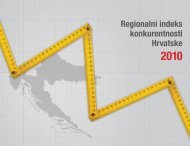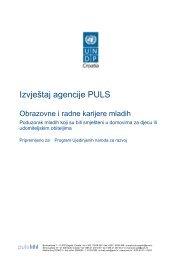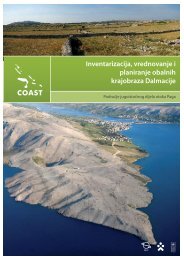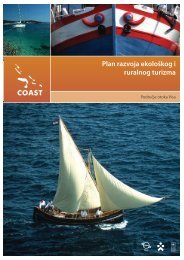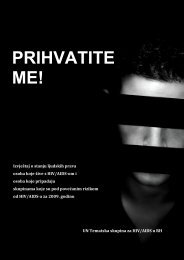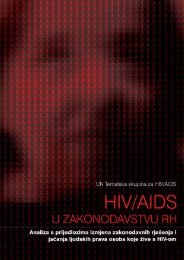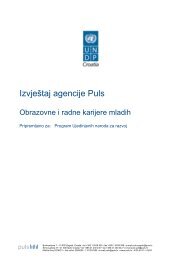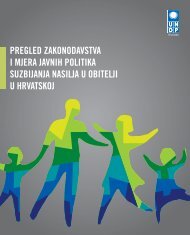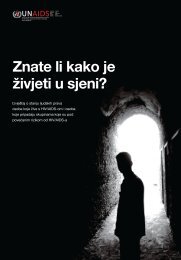WEB engleska verzija end.indd - UNDP Croatia
WEB engleska verzija end.indd - UNDP Croatia
WEB engleska verzija end.indd - UNDP Croatia
- No tags were found...
Create successful ePaper yourself
Turn your PDF publications into a flip-book with our unique Google optimized e-Paper software.
THE SOCIALLY EXCLUDEDCHAPTER 3“youth fri<strong>end</strong>ly”. Although young people t<strong>end</strong> to give abetter grade to the quality of health services, 114 they arealso in need of such services less frequently.3.8.3 Access to EducationThe illiteracy rate in <strong>Croatia</strong> is 3%. The system ofsecondary and post-secondary education is availableto most young people. Most educational costs arecovered by the state, and students are only requiredto maintain a certain level of performance. In 2006,less than 50% of students received government assistancewith educational costs. Some costs are stillborne by the students such as transport costs forthose who must travel to secondary schools outsideof their community. Accommodation costs can alsopose a problem, with most dorm facilities undersizedcompared to the student body.In 2005, <strong>Croatia</strong>n Universities began to apply theBologna Process as a step towards joining the widerEuropean community of higher education institutions.In general, the youth in <strong>Croatia</strong> receive a similareducation to their European colleagues (for example,71% of survey respondents aged 15-24 understandthe written English language very well), but theeducational system itself is archaic, suffering fromobsolete methods, older faculty, and more reproduction-basedthan experience-based learning. The averageduration of studies in <strong>Croatia</strong> is about 7 years, andmany students are forced to work in parallel with theirstudies to cover their educational costs (especially ifthey study outside their place of residence).3.8.4 Access to Employment andEmployment ServicesSome research has indicated that the likelihood ofemployment for young people under 24 is 39.6%, andfor those between the ages of 25-34 it is 44.4%. Thisdoes not compare favourably with other membernations of the European Union however the rate ofyouth unemployment varies considerably from onecountry to another, being as low as 10% in Austria,and as high as 33% in Slovakia in 2003. Youth unemploymentin <strong>Croatia</strong> has never fallen below 32%, butit declines slowly.Young people often do not have sufficient experienceto get their first job, but need their first job in order toget experience. The state has recognised this problemand has adopted - within the National Action Planfor Employment for the Period from 2005 to 2008 115- the Annual Plan of Incentives for Employment for2006. 116 This plan includes measures for co-financingthe employment of young people without workingexperience, and subsidised employment for 1,036people under 29 years of age. In addition, subsidisedinterest on entrepreneurial loans is to be provided forentrepreneurs under 29 years of age. Unfortunately,there are more than 100,000 unemployed youth forwhich these somewhat limited measures will onlyslightly improve the overall picture. Part of the problemlies in the fact that these measures only apply tolong-term unemployed youth. The state must regardthe problem of extensive youth unemployment aspart of the wider economic problem, bearing in mindall the existing levels of unemployed youth, such ashighly educated people, youth without secondaryeducation, etc.3.8.5 Access to TransportationIn larger urban centres, young people can benefitfrom well established public transportation (e.g., inZagreb, secondary school students can ride city transportationfor free, while annual passes for universitystudents are about 1/6 the price of a standard pass).Unfortunately, this service is not universal across<strong>Croatia</strong>, where most young people do not have accessto proper transportation infrastructure, whichlimits their access to education, cultural events, etc.However, people throughout <strong>Croatia</strong> who are under26 can travel by rail at a 30% discount which providesbetter mobility for young individuals.114 <strong>UNDP</strong> (2006b). Reserach onSocial Exclusion in <strong>Croatia</strong>: Groups with increased risk of Social Exclusion – focus group. <strong>UNDP</strong>, Zagreb,<strong>Croatia</strong>.115 http://www.mingorp.hr/default.asp?id=11116 http://www.vlada.hr/Download/2004/12/02/54-011.pdf85



